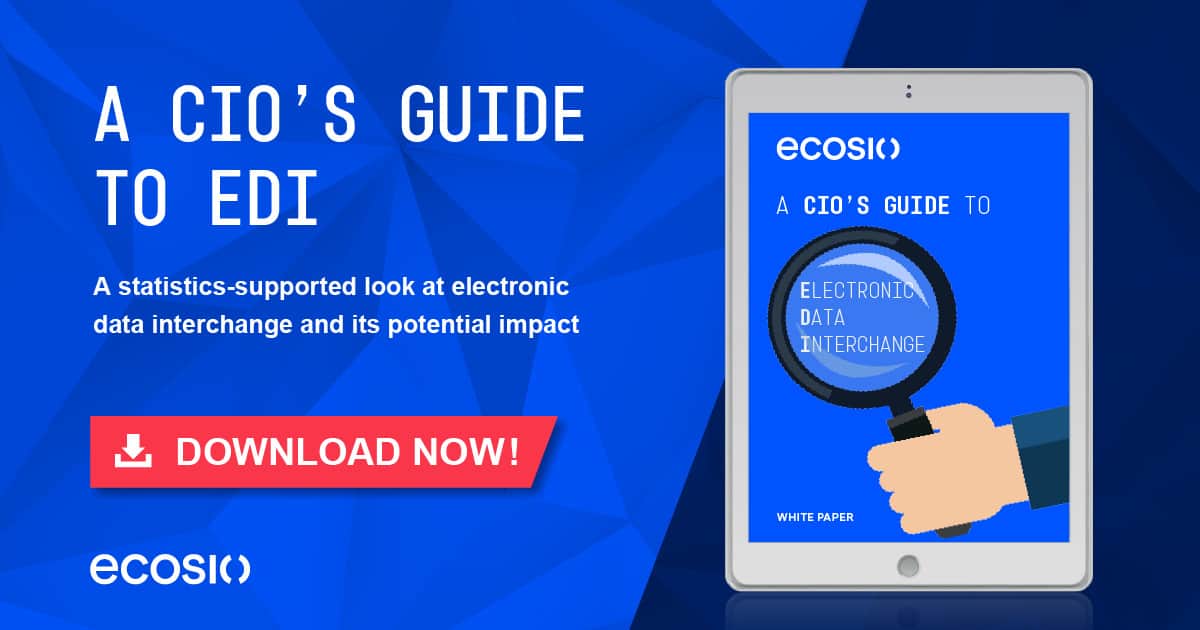While every business is different, the mistakes companies make with regard to EDI are typically very similar. In this article we’ll explore the three main areas where people go wrong plus what questions you can ask and which actions you can take to avoid making the same mistakes.
EDI PITFALL #1: Trying to do too much in-house
For businesses with large internal teams and a great deal of EDI expertise, handling EDI in-house may well be logical. Realistically, this solution only makes sense for very few businesses, however. Plus, even if you are a large player and you run a large EDI solution inhouse, there is potential for a fully managed EDI solution – e.g. on a “routing only” basis for instance. If you are considering handling EDI in-house, first ask yourself…
Will managing EDI in-house actually save me money?
When all the costs relating to mapping, message monitoring, partner communication, update installation, infrastructure hosting/renewal, staff etc. are factored in, inhouse solutions generally work out to be more expensive than fully managed solutions.
Will the solution be reliant on individuals?
No matter how well your solution is run, if its operation relies heavily on a few individuals your business is at risk. From sickness and injury to job change and retirement, there are many potential ways that a successful system can be disrupted when it is operated internally by a small number of people.
Does my team have the knowledge?
Unfortunately EDI expertise is rare. As a result, EDI tasks are often assigned to people for whom EDI is not their main area of expertise. What’s more these people also typically have to juggle EDI tasks with their other responsibilities. With time, such a situation can lead to a deterioration in efficiency and to a dependency on individual persons in the company.
Can my team cope with the workload?
Even if your team IS very experienced in EDI, change (e.g. to your EDI or ERP infrastructure) and growth (e.g. new onboardings or mergers/acquisitions) can still result in workloads increasing rapidly, which reduces the speed of potential expansion, multiplies the likelihood of errors occurring, and decreases the flexibility to react to upcoming changes.
Could staff be adding more value elsewhere?
By having to focus on message exchange, internal teams are also prevented from focussing on more value-adding activities. Moreover, with internal solutions the responsibility for successful message exchange lies completely with the company in question.
50% of respondents noted that moving to fully managed EDI freed up existing IT staff for other productive activities.
EDI PITFALL #2: Not looking at the bigger picture
Unfortunately, people are often unaware of how inefficient and complex their EDI solutions are. Instead of looking at the bigger picture and seeking to improve key processes, people are typically more concerned with ensuring their current system is running correctly. As a result, many businesses persevere with inefficient EDI systems for far too long. It’s important to remember that just because supply chains can be complex, it doesn’t follow that your EDI landscape has to be too.
With this in mind, it is important to…
Avoid multiple solutions where possible
As EDI needs change and partner networks grow, it’s common for more EDI connections to be added over time (e.g. to handle the routing of messages via a new Value Added Network (VAN)). This increases complexity, which in turn increases the time needed to complete operational tasks… and thus costs. Plus higher complexity means more chance of message failures occurring and difficulty in finding the error source quickly.
Implement a system that will allow for easy growth
Flexibility is key when selecting an EDI solution. By neglecting to implement a solution that can evolve alongside your business and in step with relevant industry and regulatory developments, you may be inhibiting your capacity to grow.
By 2025, 80% of B2B sales interactions between suppliers and buyers will occur in digital channels.
EDI PITFALL #3: Being scared of changing a running system
Given how central EDI is to modern supply chains, it’s understandable that decision makers want to avoid disruption at all costs. However, it is important to note the following…
Just because your system is running, it doesn’t mean it isn’t holding you back!
While EDI ostensibly serves just one main purpose – streamlining data exchange between business partners – EDI solutions differ greatly from one another in terms of the success with which they manage this and the benefits they offer to users. Those without fully managed EDI are missing out on the full potential EDI has to offer and will be at a competitive disadvantage!
Change doesn’t mean disruption
As all testing is conducted on a parallel system and thoroughly checked before being put live, there is no risk associated with moving to a fully managed solution.
Failing to switch will continue to hold you back
Ironically, by delaying switching to a more efficient and reliable solution out of fear of disrupting existing processes, you are taking a far bigger risk than by simply migrating!
By using electronic invoice messages for 84% of its purchase orders, the UK retail grocery sector saved £193m in one year.
Want more information?
This article is taken from our white paper “A CIO’s Guide to Electronic Data Interchange”. In this white paper we also explore the reasons behind the recent shift towards fully managed EDI, how an efficient EDI solution can benefit your business, and the simple steps you can take to ensure you select the right solution.
Download your free copy of “A CIO’s Guide to Electronic Data Interchange”, simply enter your details.
Alternatively, if you have any questions about your particular situation or anything else EDI related, please do not hesitate to get in touch! We are always happy to help however we can.













